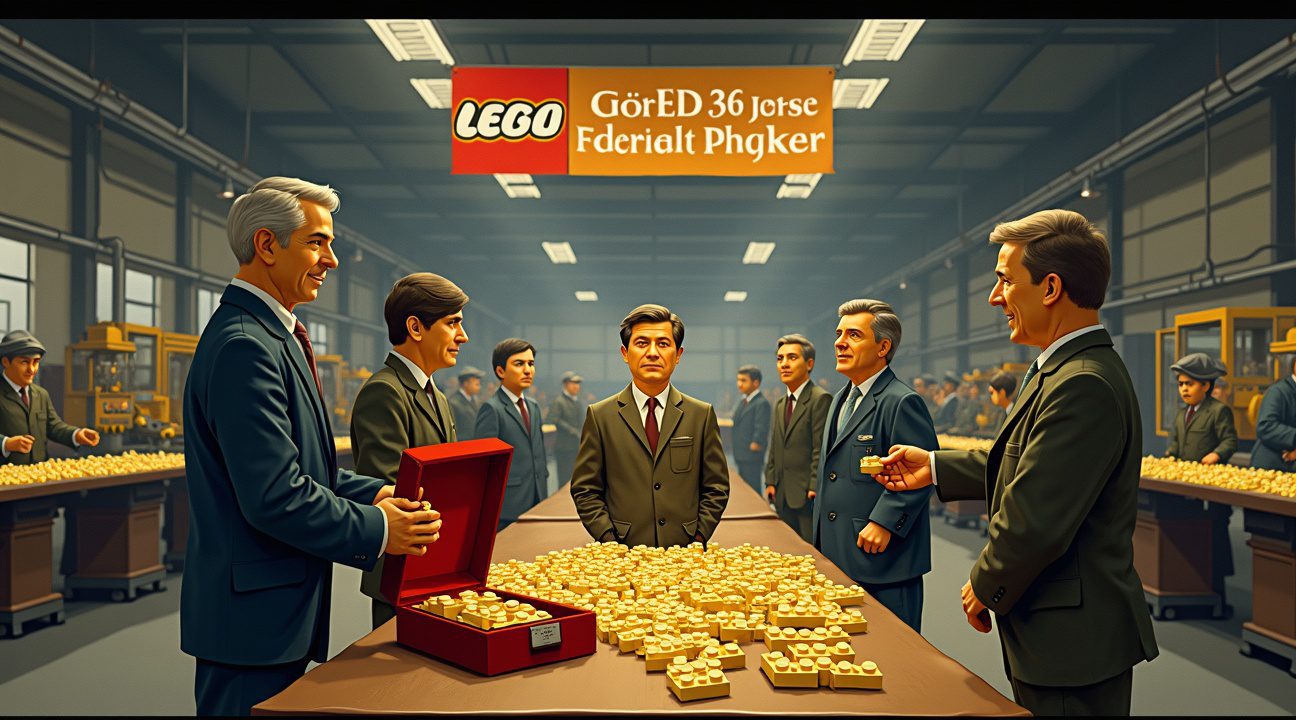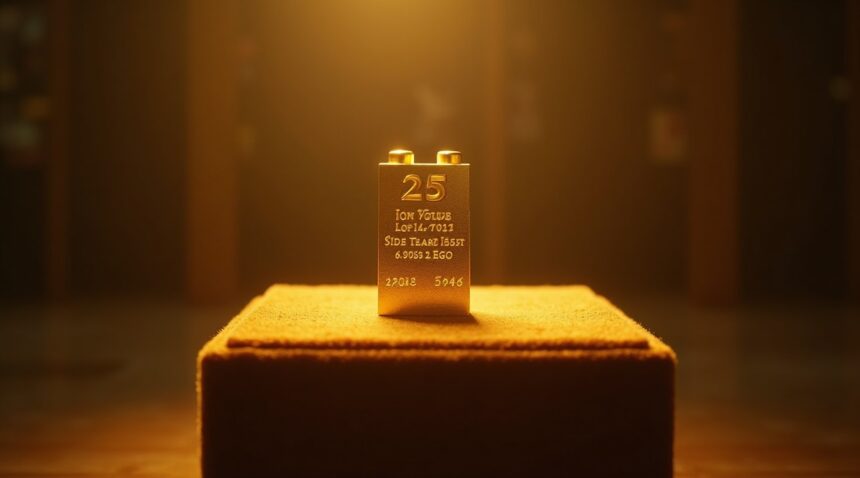Between 1979 and 1981, LEGO created one of the most extraordinary employee recognition programs in corporate history by awarding solid 14-karat gold LEGO bricks to employees who completed 25 years of service.
These functional gold bricks, valued at approximately $15,000 each, were primarily distributed to factory workers at the Hohenwestedt facility in Germany. With fewer than 100 pieces produced, they have since become legendary collectibles within the LEGO community.
Key Takeaways
- LEGO crafted solid 14-karat gold bricks as 25-year service awards between 1979 and 1981. Each brick, valued at approximately $15,000, maintained the exact specifications of a standard 2×4 LEGO piece.
- Awarded mainly to factory workers at LEGO’s Hohenwestedt facility in Germany, making this recognition a symbol of internal legacy and exclusivity for a small group of long-term employees.
- Each brick was uniquely engraved with the recipient’s name and years of service. This transformed every award into a personalized keepsake that stood apart from typical corporate tokens.
- Fewer than 100 gold bricks are known to exist today, making them one of the most coveted treasures for LEGO enthusiasts, often referred to as the “holy grail” of LEGO collectibles.
- The bricks represent genuine corporate heritage and are non-replicable. Their value stems not only from the gold content but from their origin as earned employee awards rather than purchasable items.
For more about LEGO history and collectible culture, explore the comprehensive resources available at the official LEGO website or dive into fan-led communities that discuss rare builds and exclusive memorabilia.
The Ultimate Corporate Recognition: A $15,000 Gold LEGO Brick
Between 1979 and 1981, LEGO established one of the most extraordinary employee recognition programs in corporate history. The Danish toy company crafted solid 14-karat gold LEGO bricks as milestone awards for employees who dedicated 25 years of service to the organization.
These weren’t decorative replicas or simplified tokens. Each gold brick maintained the exact specifications of a standard 2×4 LEGO piece, complete with functional studs and tubes that seamlessly connected with regular plastic bricks. The company spared no expense in creating these remarkable tokens of appreciation, with each brick valued at approximately $15,000 during the program’s active years.
Personalized Excellence in Employee Recognition
LEGO personalized each gold brick with the recipient’s name and years of service engraved directly onto the precious metal. This attention to detail transformed what could have been a generic corporate gift into a truly unique keepsake that honored individual dedication and loyalty. The engraving process ensured no two bricks were identical, creating exclusive artifacts that reflected each employee’s personal journey with the company.
The program’s timing coincided with LEGO’s rapid global expansion during the late 1970s and early 1980s. As the company stretched its reach across international markets, leadership recognized the importance of acknowledging the veteran employees who had built the foundation for this growth. Rather than settling for conventional milestone gifts like watches or plaques, LEGO chose to honor their workforce with something that embodied the very essence of their brand.
Modern collectors estimate these gold bricks maintain their value remarkably well, with current appraisals ranging between $14,450 and $15,000. The rarity factor significantly contributes to this sustained valuation, as only a limited number of employees achieved the 25-year milestone during the program’s brief three-year window. Each surviving brick represents both the company’s commitment to employee appreciation and a fascinating piece of corporate memorabilia.
The weight and feel of solid 14-karat gold elevated these awards far beyond typical recognition gifts. Recipients received something that functioned as both a prestigious honor and a valuable asset. Unlike traditional service awards that often gather dust on shelves, these gold bricks served as conversation pieces that demonstrated LEGO’s innovative approach to employee relations during a pivotal period in the company’s evolution.
The Exclusive Hohenwestedt Factory Origins
The Hohenwestedt factory in Germany stands as the epicenter of LEGO’s most exclusive employee recognition tradition. This specific facility became the primary location where LEGO awarded gold bricks to long-serving employees during the early 1980s, establishing a practice that would become legendary among collectors and company historians alike.
Selective Distribution and Factory-Specific Recognition
LEGO didn’t distribute these gold bricks company-wide or to every employee who reached the 25-year milestone. Instead, the company focused this special recognition primarily on factory workers at the Hohenwestedt location who had dedicated over a quarter-century to their roles. This selective approach created an incredibly exclusive group of recipients, making each gold brick exponentially more valuable and sought-after within collecting circles.
The decision to concentrate this recognition program at one facility speaks to the unique culture and operational significance of the German factory. Factory staff members who received these awards represented a core group of experienced workers whose loyalty and expertise had directly contributed to LEGO’s manufacturing excellence. Their hands-on involvement in the production process made them ideal candidates for this distinctive honor.
This geographic limitation further enhanced the rarity of authentic gold bricks. While LEGO operated multiple facilities across different countries, only employees at this specific German location typically qualified for the gold brick reward. The concentration of awards at Hohenwestedt created a clear provenance trail that collectors and enthusiasts value today when authenticating these pieces.
The exclusivity extends beyond just location requirements. Even within the Hohenwestedt facility, not every long-term employee automatically received a gold brick. The company maintained strict criteria for distribution, ensuring that recipients truly represented the highest standards of dedication and service. This careful selection process made each award meaningful both to the recipient and to the broader LEGO community.
Understanding this factory-specific origin helps explain why authentic gold bricks remain so scarce in today’s market. The limited pool of eligible employees, combined with the specific timeframe of distribution and single-location focus, created natural scarcity that continues to drive collector interest decades later. Many of these original recipients likely kept their gold bricks as personal mementos rather than selling them, further restricting availability.
The Hohenwestedt tradition also distinguished itself from other LEGO employee recognition programs implemented at different facilities or time periods. While LEGO has maintained various appreciation initiatives throughout its history, the gold brick program represents a unique chapter tied specifically to this German location and its workforce. This specificity adds historical significance that resonates with both gaming enthusiasts and collectors who appreciate limited-edition items with clear provenance.
The factory’s role in establishing this tradition reflects LEGO’s commitment to honoring long-term employees who contributed to the company’s manufacturing excellence. These workers had witnessed firsthand the evolution of LEGO production techniques, quality standards, and product development over their extended careers. Their institutional knowledge and hands-on experience made them invaluable assets worthy of special recognition.
Today, the Hohenwestedt connection serves as a crucial authentication factor for collectors evaluating potential gold brick acquisitions. Knowing the specific factory origins helps distinguish genuine employee awards from later reproductions or commemorative pieces that lack the historical significance of the original program. This geographic specificity continues to influence how collectors, auction houses, and LEGO historians approach these remarkable artifacts.
The concentration of gold brick distribution at this single facility created a legacy that extends far beyond the original recognition program, establishing Hohenwestedt as a significant location in LEGO’s corporate history and collector culture.

Why These Bricks Became Legendary Collectibles
Fewer than 100 gold bricks are believed to exist based on anecdotal evidence from collectors, creating an almost mythical status within the LEGO collecting community. This extreme scarcity has transformed these simple employee recognition tokens into some of the most coveted items in the entire LEGO universe. The rarity factor alone elevates these pieces far beyond typical collectible status.
The legend surrounding these gold bricks continues to grow with each passing year. LEGO collectors consider these artifacts the holy grail of LEGO memorabilia, representing not just rarity but authentic corporate history. Private collection circles guard information about these bricks carefully, with many owners preferring to keep their possession secret rather than risk unwanted attention from fellow enthusiasts.
The Economics of Extreme Rarity
The valuation of these gold bricks defies traditional collectible logic. While the actual gold content contributes minimally to their worth, the historical significance and LEGO brand mystique drive values into five-figure territory when they rarely surface at auction. Collectors focus less on material composition and more on the story these bricks tell about LEGO’s corporate culture and employee appreciation practices.
Private collection networks have become the primary marketplace for these legendary items. Traditional auction houses seldom see these pieces, as most transactions occur through discreet collector-to-collector exchanges. The gaming community and other hobbyist sectors have witnessed similar phenomena with ultra-rare items, but few match the mystique surrounding LEGO’s gold bricks.
Acquiring one of these bricks requires patience, connections, and significant financial resources. They cannot be purchased through any official LEGO channel, making them fundamentally different from limited edition sets or promotional items. The only legitimate path to ownership remains earning them through 25 years of service or finding someone willing to part with their piece of LEGO history.
The combination of corporate loyalty, collectible culture, and brand recognition creates a perfect storm of desirability. These gold bricks embody everything collectors seek:
- Authenticity
- Rarity
- Historical significance
- Connection to a beloved brand
They represent recognition not just for employee service but for dedication to a company that has brought joy to millions worldwide.
Collectors often describe these bricks as the ultimate LEGO collectible because they cannot be manufactured, reproduced, or officially reissued. Each brick carries the weight of someone’s quarter-century commitment to the LEGO organization, making them deeply personal artifacts that transcend typical collecting motivations.
The legend status these bricks have achieved continues to influence the broader LEGO collecting market. They serve as a benchmark for rarity and value, inspiring collectors to seek other unique pieces while knowing that nothing quite matches their significance. Even experienced collectors who have never seen one in person speak about them with reverence, understanding that these gold bricks represent something special within the collectible landscape.
The mystique extends beyond simple ownership into the stories surrounding these pieces. Each brick connects to an individual’s career journey, family legacy, and personal relationship with the LEGO brand. This emotional dimension adds layers of meaning that pure rarity cannot achieve, cementing their position as legendary collectibles that capture imaginations across generations of LEGO enthusiasts.
Sources:
AOL, “This is the Incredible $15,000 Reward Lego Gives to Its Longtime Employees”
The Mary Sue, “LEGO Gave Their Employees Gold Bricks After 25 Years of Service”
Brickipedia, “14 Karat Gold Brick”


